Written by Bro. Robert Swanson, Lodge Education Officer
Last month we took a quick trip through the history & origins of Tracing Boards. We also introduced the three Tracing boards within the Lodge room of Alexandria-Washington 22 and provided a brief summation of the symbols to be found in the Entered Apprentice Tracing board. Let us now look more deeply into the Fellowcraft Tracing board and the symbols to be found within. If you see any other symbols of relevance or import, please share!
The Different Lessons Represented in the Fellowcraft Tracing Board
The Two Pillars, surmounted by the Globes – Celestial and terrestrial.
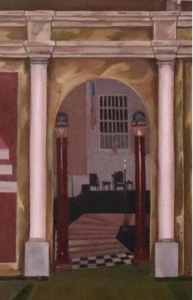 What is exquisite about this particular frame which can be seen in the Tracing board bottom right are actually the Two Pillars surmounted by the Globes that exist in the AW-22 Lodge room as seen from the West-Gate whence the candidate enters the Lodge room. However, at AW22 when not enacting the FC Degree they are stationed around the Junior Warden’s station.
What is exquisite about this particular frame which can be seen in the Tracing board bottom right are actually the Two Pillars surmounted by the Globes that exist in the AW-22 Lodge room as seen from the West-Gate whence the candidate enters the Lodge room. However, at AW22 when not enacting the FC Degree they are stationed around the Junior Warden’s station.
“Next, the doctrine of the Spheres as illustrated in the Sciences of Astronomy and Geography by the Globes of Celestial and Terrestrial”[i]
“the newly-obligated Fellow Craft is conducted to a site representing the porch of K-S-T. Thereupon, the first objects to which his attention is drawn are the Brazen Pillars, Jachin and Boaz, which are said to be representations of those that stood on the porch, flanking the entrance to the Temple. The word Jachin is said to denote establishment, and Boaz signifying strength. Taken together, they may be interpreted as “In strength shall this house be established.” [ii]
The Winding Staircase
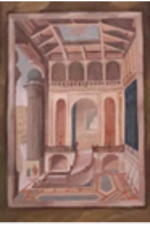 “we are now about to make an ascent through a porch, by a flight of winding stairs, consisting of three, five and, seven steps, to a place representing the Middle Chamber of King Solomon’s Temple, there to receive instructions relative to the wages due, and the jewels of a Fellow Craft”[iii] “Symbolically, the Winding Staircase represents a journey- it implies motion, evolution and transformation. That the staircase winds is symbolic of the time, effort and dedication required of the Fellow Craft in his pursuit of knowledge”[iv]
“we are now about to make an ascent through a porch, by a flight of winding stairs, consisting of three, five and, seven steps, to a place representing the Middle Chamber of King Solomon’s Temple, there to receive instructions relative to the wages due, and the jewels of a Fellow Craft”[iii] “Symbolically, the Winding Staircase represents a journey- it implies motion, evolution and transformation. That the staircase winds is symbolic of the time, effort and dedication required of the Fellow Craft in his pursuit of knowledge”[iv]
“As a Fellow Craft, he has advanced another step, and as the degree is emblematic of youth, so it is here that the intellectual education of the candidate begins. And therefore, here, at the very spot which separates the porch from the sanctuary, where childhood ends and manhood begins, he finds stretching out before him a Winding Stair which invites him, as it were, to ascend, and which, as the symbol of discipline and instruction, teaches him that here must commence his Masonic labor – here he must enter upon those glorious though difficult researches, the end of which is to be the possession of Divine Truth.”[v]
The Middle Chamber of King Solomon’s Temple
“This journey to the Middle Chamber, like many of the ceremonies of Freemasonry, is based upon one of the legends connected with the building of King Solomon’s Temple…On the evening of the sixth day those who had proved themselves worthy by a strict attention to their duties, were entrusted with certain mysterious words, signs, and grips, by means of which they were enabled to work their way to the Middle Chamber of the Temple to receive their wages”[vi]
“The so-called Middle Chamber is believed to have been in fact the middle story, extending around the main building as far as the second floor extended, as was used, it is supposed, for the priests and their vessels…used in sacrificial and other ceremonies. For ritualistic purposes, the Middle Chamber is appropriated to the Fellow Crafts.”[vii]

The Five Orders of Architecture – Tuscan, Doric, Ionic, Corinthian, and Composite.
However only three are depicted in the painting: Doric, Ionic, and Corinthian.
“The ancient and original Orders of Architecture revered by Masons. Are no more than three – the Doric, Ionic, and Corinthian, which were invented by the Grecians”[viii]
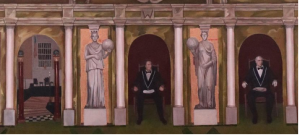
Doric
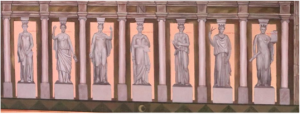
Ionic
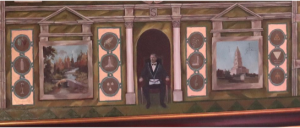
Corinthian
The Five Senses
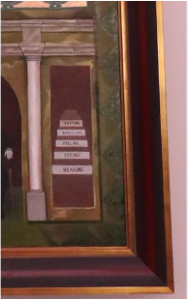 “The Five Senses of Human Nature, to-wit: Hearing, Seeing, Feeling, Smelling, and Tasting, come next in order-the first three of which are most revered by Masons, for reasons which must be apparent to every enlightened Craftsman”[ix]
“The Five Senses of Human Nature, to-wit: Hearing, Seeing, Feeling, Smelling, and Tasting, come next in order-the first three of which are most revered by Masons, for reasons which must be apparent to every enlightened Craftsman”[ix]
Though the Lambskin apron is not discussed in the 2nd Degree in Masonry Albert Mackey makes a wonderful allusion to the 5 senses compared with how an Entered Apprentice wears their Apron.
Mackey notes than as an EA “we wear it with the flap raised, forming a “five cornered badge” which is an allusion to our five senses that we use in relation to this physical world. When we combine the triangular flap with the quadrangular portion below it, it symbolizes a connection between the soul and body.[x]
The Seven Liberal Arts and Sciences
“the Seven Liberal Arts and Sciences, to-wit: Grammar, Rhetoric, Logic, Arithmetic, Geometry, Music and Astronomy. Passing Over most of these, each of which affords a large field for the accomplished Scholar and Mason to dilate upon, we are arrested by the fifth Science, or Geometry, which treats of the powers and properties of Magnitudes in general, where length, breadth and thickness are concerned, from a point to a line, from a line to a superfice, and from a superfice to solid.”[xi]

The Mosaic Pavement
 “The Mosaic Pavement is a representation of the ground floor of King Solomon’s Temple; the indented Tessel, of that beautiful border or skirting which surrounded it; and the Blazing Star is an emblem of Deity or an overruling Providence…The Mosaic Pavement is emblematical of human life, checkered with good and evil; the beautiful border which surrounds it, of the manifold blessings and comforts which surround us, and which we hope to enjoy by a faithful reliance on Divine Providence, which is hieroglyphically represented by the Blazing Star in the center”[xii]
“The Mosaic Pavement is a representation of the ground floor of King Solomon’s Temple; the indented Tessel, of that beautiful border or skirting which surrounded it; and the Blazing Star is an emblem of Deity or an overruling Providence…The Mosaic Pavement is emblematical of human life, checkered with good and evil; the beautiful border which surrounds it, of the manifold blessings and comforts which surround us, and which we hope to enjoy by a faithful reliance on Divine Providence, which is hieroglyphically represented by the Blazing Star in the center”[xii]
The symbol of the sheaf of wheat or ear of Corn, suspended at or near a Water-ford
Orientation on the wall
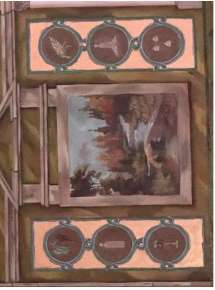
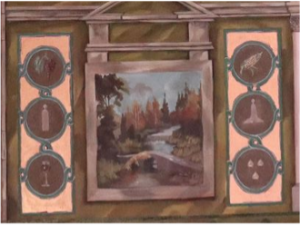
The lessons of the Corn, Wine and Oil
“You have now arrived at the Middle Chamber where you are received and recorded a Fellow Craft. You are now entitled to wages, as such; which are, the Corn of nourishment, the Wine of refreshment, and the Oil of joy, which denote peace, harmony, and strength”[xiii]
“Corn, meaning “seed of a cereal plant”…was used to refer to oats, wheat, barley, and others generally”[xiv]
“Corn, Wine, and Oil are the Masonic elements of consecration. The adoption of these symbols is supported by the highest antiquity. Corn, Wine and Oil were the most important productions of Eastern counties; they constituted the wealth of the people, and were esteemed as the supports of life and the means of refreshment David enumerates them among the greatest blessings that we enjoy, and speaks of them as “wine that maketh glad the heart of man, and oil to make his face to shine, and bread which strengtheneth mans heart” (Psalm civ.,15)”[xv]
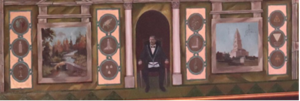
Sources:
[i] Presentation Volume Grand Lodge of A F & AM of the Commonwealth of Virginia page 80
[ii] Jamie Paul Lamb Approaching the Middle Chamber page 50
[iii] IBID page 69
[iv] Ibid page 69
[v] Mackey’s Encyclopedia Volume II page 1108
[vi] Mackey’s Encyclopedia Volume II page 665
[vii] Coils Masonic Encyclopedia page 416
[viii] Presentation Volume Grand Lodge of A F & AM of the Commonwealth of Virginia page 81
[ix] IBID 83
[x] Wilmshurst’s “Meaning of Masonry” Page 31
[xi] Presentation Volume Grand Lodge of A F & AM of the Commonwealth of Virginia page 82
[xii] Presentation Volume Grand Lodge of A F & AM of the Commonwealth of Virginia page 66
[xiii] Jamie Paul Lamb Approaching the Middle Chamber page 387
[xiv] Ibid page 388
[xv] Mackey’s Encyclopedia Volume I page 245



